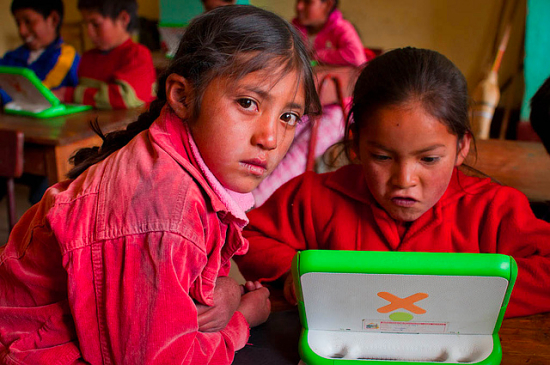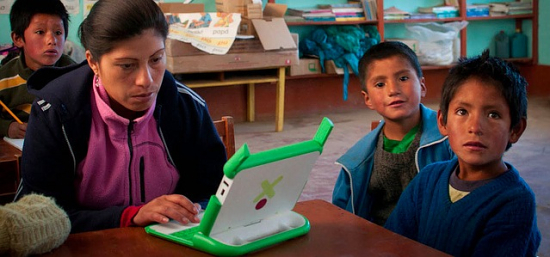
Jeff Patzer, a 2010 OLPC intern in Peru, is publishing an amazing set of posts where he tries to explain why the OLPC Peru "Una Laptop Por Nino" is failing. His conclusions draw on his observations and experiences spanning twenty schools and countless interactions with the ministry and teachers over a period of approximately three months. And Jeff's overall impression?
One thing was for sure, the teachers were not going to get the help they needed from the [Peruvian Ministry of Education]. The ministry was only good for lip service. They were in Lima, talking about the things that were happening, rather than in the field making it happen. As a friend of mine said, they were busy practicing "mental masturbation".
Yes, its a stinging indictment of the One Laptop per Child Negropontism that "You Can Give Kids XO Laptops and Just Walk Away." Jeff has seemingly concluded (as did Christoph Derndorfer in "A Problematic Una Laptop Por Niño Program), that this drive-by implementation model has only one outcome: laptops are getting opened and turned on, but then kids and teachers are getting frustrated by hardware and software bugs, don't understand what to do, and promptly box them up to put back in the corner.
Below, I've highlighted passages from each of Jeff's post that should have you clicking through to read more.

I had hoped that the interns over the summer would have been able to provide some context for the situation we might encounter. All I really knew was how to use the laptop and that they had worked in a town called Huaraz. [...]
Therefore, I had almost no idea of the actual work the interns were doing. We were assured that we would have all questions answered by the Ministry once in Peru. Essentially, the other interns Hope and Josh, and myself knew almost nothing about what we were getting ourselves into, but were excited for the opportunity.
Due to our "training" over the summer, we were to only have one day of training at the ministry. Therefore upon our arrival at the ministry, we assumed that we would be trained in how to implement the laptops with the class. However, for the whole first half of the day we spent the time with two different ladies. They continually talked about how our job was to convince the teachers to use the laptops. [...]
The major positive part of our training was we were given a copy of the Peru software image, which is needed to flash the machines. Apparently flashing the machines is the only method of fixing any problems related to the software and any hardware problems should just be reported. [...]
Essentially the key points of our jobs would be to convince teachers to use the laptops and to be glorified laptop software flashers.
As I began to visit schools, I slowly became more familiar with the laptop and its limitations. Most of the workshops the Ministry had suggested I discarded because they were cumbersome and unrealistic. The reality of most schools was they only had a basic knowledge of how to operate the laptops. Additionally, the mouse pads, besides having a terrible design, often became so dirty that they stopped functioning. The most disturbing fact we discovered though was the software image being used was over two years old. While this doesn't necessarily have to be a cause of problems, it is when the software never gets updated and bugs never get fixed. [...]
A majority of the programs have some serious issues that have not been fixed since their initial deployment. No follow-up is performed to solve problems. What is worse, is that many students and teachers cannot understand when problems occur and why they are occurring. They only understand that something is not working and get extremely frustrated. This usually causes them to abandon using the programs and also lose confidence in the laptop. To give one an idea of the severity of the issues, it took Hope, Josh, and me the course of a few months to discover a variety of errors and minor solutions to get the programs to function as intended.
actually trying to convey the idea of modifier keys beyond the use of shift and the accent mark, is almost impossible. If you show them one letter and explain that this works for all keys on the keyboard, they will not understand. Some might say this is my fault for not being able to teach them, but really it is more than that.
Showing the kids one idea and trying to explain how to extrapolate this to other ideas, just doesn't work. It's just not how the kids are taught to learn. They are not encouraged to think outside the box (a phrase which translates but holds no meaning) and problem solve. The teaching method used by the teachers is call and response or copying things from the board. Kids do not work in groups or independently to exercise critical thinking, but rather will only repeat or copy what is given to them by the teacher.
Peruvian teachers break down into two groups, those trying to get accredited and accepted as full-time teachers, they work on contracts that last a couple years, and those that are accredited and pretty much set with a job for as long as they want. Those who are contracted tend to be younger and more accepting of technology. The other ones tend to be older, 45 years plus, and have almost no experience with technology.
The younger ones tend to catch on very fast and grasp the concepts quite fast. Even if they did not know where to start, once shown they caught on fast. They were also incentivized to do better, because they wanted to get hired permanently. The unfortunate part is that these teachers really only make up about 10% of the teachers I encountered. The other group, the older ones, tended to be much more difficult to teach. Disregarding their lack of experience with technology, they also simply did not have basic training in certain topics. This consisted of not knowing basic geometry, mathematics, or other topics. The technology issue was simply compounded by the inadequate education.
The main idea here is that if the teachers were going to be able to use these laptops, they needed some serious training. The sad part is that there are tons of resources online, but most teachers do not know how to use the internet to access them. Most teachers do not even have email addresses, let alone the ability to search through google to find ideas on how to utilize the laptops. Internet access itself was non-existent in the villages, but they did have access to it in Huaraz. The opportunity was there, but the knowledge of how to take advantage of it was not.
After all this I hope that it has become clear, that there isn't just one problem, but a series of problems. OLPC built a laptop that doesn't work well and has many problems. The Peruvian ministry of education has software that is too buggy and an infrastructure not built to support the deployment. Teachers do not have the training and sadly, the ability to change their situation.
So how do you make the deployment work with what is already there?
First, fix the software and hardware bugs. [...] Second, train the teachers and follow-up. [...] Third, stop making excuses and do the hard work.